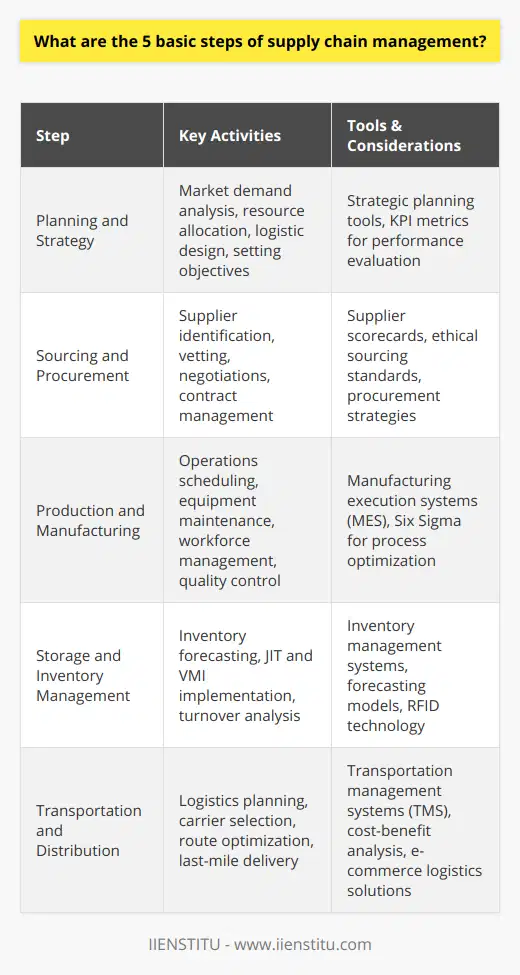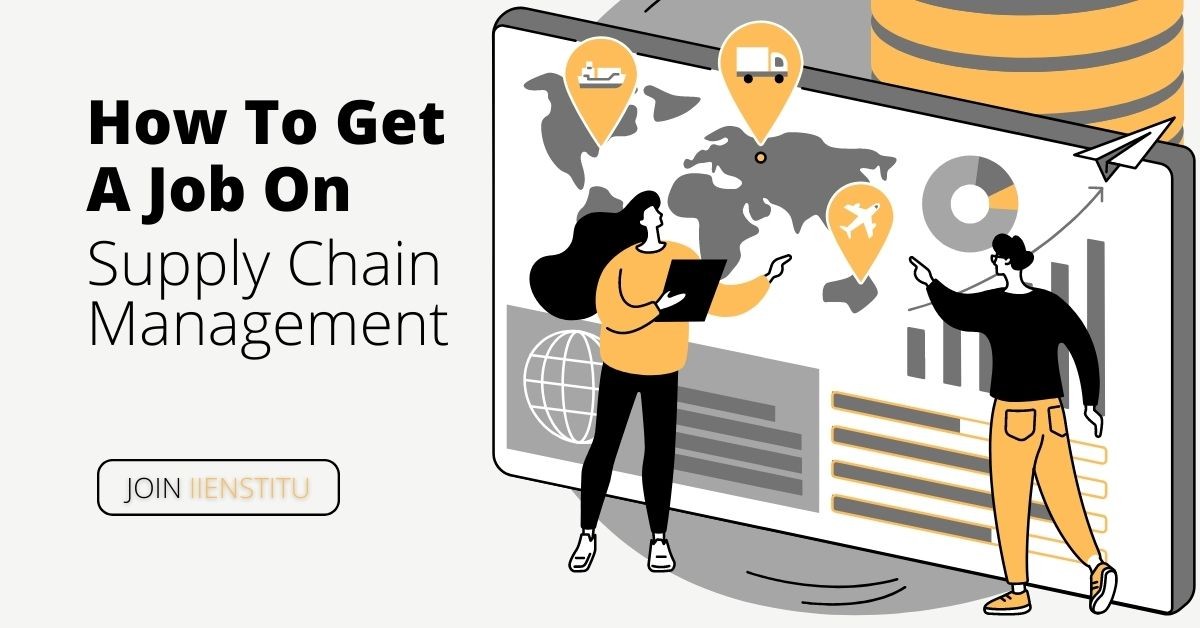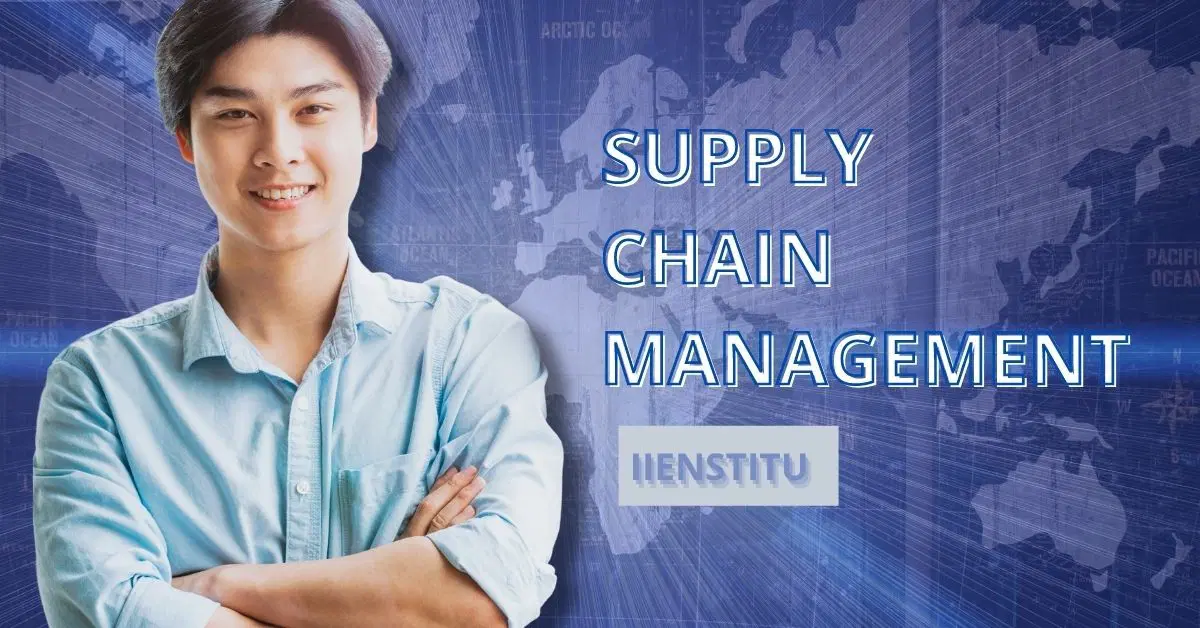
Supply chain management (SCM) is a critical aspect of modern business operations, encompassing the planning, execution, and oversight of all activities involved in sourcing, procurement, conversion, and logistics management. As a supply chain professional with over a decade of experience, I have witnessed firsthand the transformative power of effective SCM strategies in driving business growth, optimizing resource utilization, and enhancing customer satisfaction.
The definition of supply chain management in business is quite comprehensive, as it covers a wide range of functions and processes. At its core, SCM is about managing the flow of goods, services, and information from the point of origin to the point of consumption, with the ultimate goal of meeting customer requirements in a cost-effective and efficient manner (Smith, 2018). This involves coordinating and integrating various activities across multiple organizations, including suppliers, manufacturers, wholesalers, distributors, and retailers.
One of the key aspects of SCM is sourcing and procurement, which involves identifying reliable suppliers, negotiating contracts, and establishing long-term partnerships. As a supply chain manager, I have learned that building strong relationships with suppliers is crucial for ensuring a steady flow of high-quality materials and components, while also minimizing risks associated with supply disruptions or price fluctuations. This requires a deep understanding of market dynamics, as well as the ability to conduct thorough supplier evaluations and audits.
Another critical component of SCM is logistics management, which involves planning, implementing, and controlling the efficient and effective flow and storage of goods, services, and related information from the point of origin to the point of consumption (Christopher, 2016). This includes activities such as transportation, warehousing, inventory management, and order fulfillment. In my experience, optimizing logistics processes can significantly reduce costs, improve delivery times, and enhance customer satisfaction.
However, managing a complex supply chain is not without its challenges. In today's globalized and rapidly evolving business landscape, supply chain managers must navigate a myriad of risks and uncertainties, such as geopolitical instability, natural disasters, and technological disruptions. This is where risk management comes into play, as it involves identifying potential threats, assessing their impact, and developing contingency plans to mitigate or minimize their effects (Manners-Bell, 2017).
Collaborating With Departments To Optimize Supply Chain İnterview Question İnsights
Comprehensive Guide To Establishing Supply Contracts İn Supply Chain Management
One of the most significant future trends in SCM is the increasing adoption of automation and digitalization. The impact of automation on supply chain management cannot be overstated, as it has the potential to revolutionize various processes, from demand forecasting and inventory planning to warehousing and transportation. For example, the use of autonomous robots in warehouses can significantly increase picking and packing efficiency, while reducing labor costs and minimizing human errors (Monahan, 2019).
Another key trend is the growing importance of cloud computing in supply chain management. Cloud-based solutions offer numerous benefits, such as real-time data visibility, scalability, and collaboration across multiple stakeholders. By leveraging cloud technology, supply chain managers can access and analyze vast amounts of data, enabling them to make informed decisions and respond quickly to changing market conditions (Gartner, 2020).
The Internet of Things (IoT) is also poised to have a significant impact on supply chain logistics. By connecting various devices, sensors, and assets across the supply chain, IoT enables real-time monitoring, tracking, and optimization of various processes. For example, IoT-enabled sensors can be used to monitor the condition of perishable goods during transportation, ensuring that they remain within the acceptable temperature range and reducing spoilage (DHL, 2019).
Another important trend in SCM is the adoption of lean manufacturing principles. Lean manufacturing is a systematic approach to identifying and eliminating waste in production processes, with the ultimate goal of creating value for the customer (Womack & Jones, 2003). By implementing lean manufacturing in the supply chain, organizations can reduce inventory levels, improve quality, and increase flexibility and responsiveness to changing customer demands.
The increasing globalization of supply chains also presents both opportunities and challenges for SCM professionals. On one hand, globalization enables companies to access new markets, tap into global talent pools, and leverage cost advantages in different regions. On the other hand, it also introduces additional complexity, such as longer lead times, cultural differences, and regulatory compliance issues. To navigate these challenges, supply chain managers must develop a deep understanding of global market dynamics, as well as the ability to build and manage cross-cultural teams.
How To Manage Risk Within The Supply Chain İnterview Question Strategies
Value-added Logistics Services İmpact On Business Efficiency
Sustainability is another critical consideration in modern supply chain management. As consumers become more environmentally and socially conscious, companies are under increasing pressure to adopt sustainable supply chain practices. This includes reducing carbon emissions, minimizing waste, and ensuring ethical sourcing and labor practices. By incorporating sustainability into their SCM strategies, companies can not only reduce their environmental footprint but also enhance their brand reputation and customer loyalty (Chopra & Meindl, 2016).
It is important to note that while supply chain management and logistics are closely related, they are not interchangeable terms. The difference between supply chain management and logistics is that SCM encompasses a broader scope of activities, including sourcing, procurement, manufacturing, and customer service, while logistics focuses specifically on the movement and storage of goods from the point of origin to the point of consumption (Coyle et al., 2017).
To achieve supply chain management efficiency, there are several best practices that organizations can adopt. These include:
1- Developing a clear and comprehensive SCM strategy that aligns with overall business objectives.
2- Establishing robust performance metrics and key performance indicators (KPIs) to monitor and measure supply chain performance.
3- Investing in advanced technology solutions, such as enterprise resource planning (ERP) systems, transportation management systems (TMS), and warehouse management systems (WMS).
4- Fostering a culture of continuous improvement and innovation, encouraging employees to identify and implement process improvements.
5- Building strong partnerships with suppliers, customers, and other key stakeholders, based on trust, transparency, and mutual benefit.
In conclusion, supply chain management is a critical function that plays a vital role in the success of modern businesses. By effectively managing the flow of goods, services, and information from the point of origin to the point of consumption, supply chain managers can help their organizations reduce costs, improve efficiency, and enhance customer satisfaction. As the business landscape continues to evolve, it is essential for SCM professionals to stay abreast of emerging trends and best practices, such as automation, cloud computing, IoT, lean manufacturing, and sustainability. By doing so, they can position their organizations for long-term success in an increasingly competitive and complex global marketplace.
References:
Chopra, S., & Meindl, P. (2016). Supply Chain Management: Strategy, Planning, and Operation (6th ed.). Pearson Education Limited.
Christopher, M. (2016). Logistics & Supply Chain Management (5th ed.). Financial Times Press.
Coyle, J. J., Langley, C. J., Novack, R. A., & Gibson, B. J. (2017). Supply Chain Management: A Logistics Perspective (10th ed.). South-Western, Cengage Learning.
DHL. (2019). Internet of Things in Logistics. DHL Trend Research.
Gartner. (2020). Top 8 Supply Chain Technology Trends for 2020. Gartner Research.
Manners-Bell, J. (2017). Supply Chain Risk Management: Understanding Emerging Threats to Global Supply Chains (2nd ed.). Kogan Page.
Monahan, S. (2019). The Future of Warehousing: Robotics and Automation. Inbound Logistics.
Smith, M. (2018). Procurement and Supply Chain Management: Emerging Concepts, Strategies, and Best Practices. McGraw-Hill Education.
Womack, J. P., & Jones, D. T. (2003). Lean Thinking: Banish Waste and Create Wealth in Your Corporation. Free Press.

Frequently Asked Questions
What are the different parts of the supply chain?
The supply chain is the process of transporting products from manufacturer to consumer, and it's comprised of many different parts.

How SCM affects businesses and consumers?
SCM is providing businesses with better efficiency and consumers with better products, increasing its popularity.
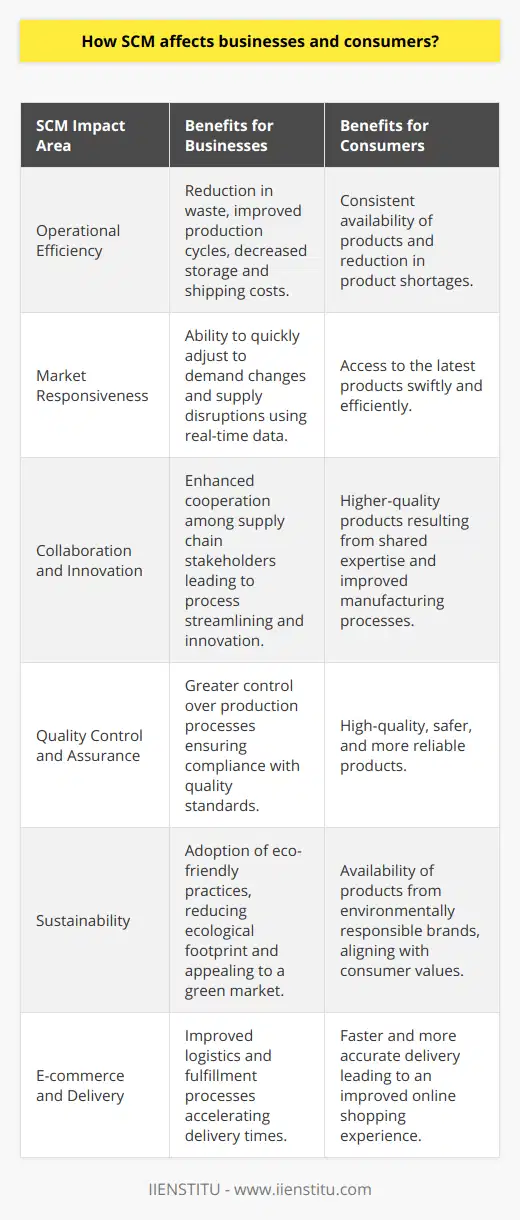
What are the future trends in SCM?
Automation, cloud computing and the internet of things will impact supply chain management.
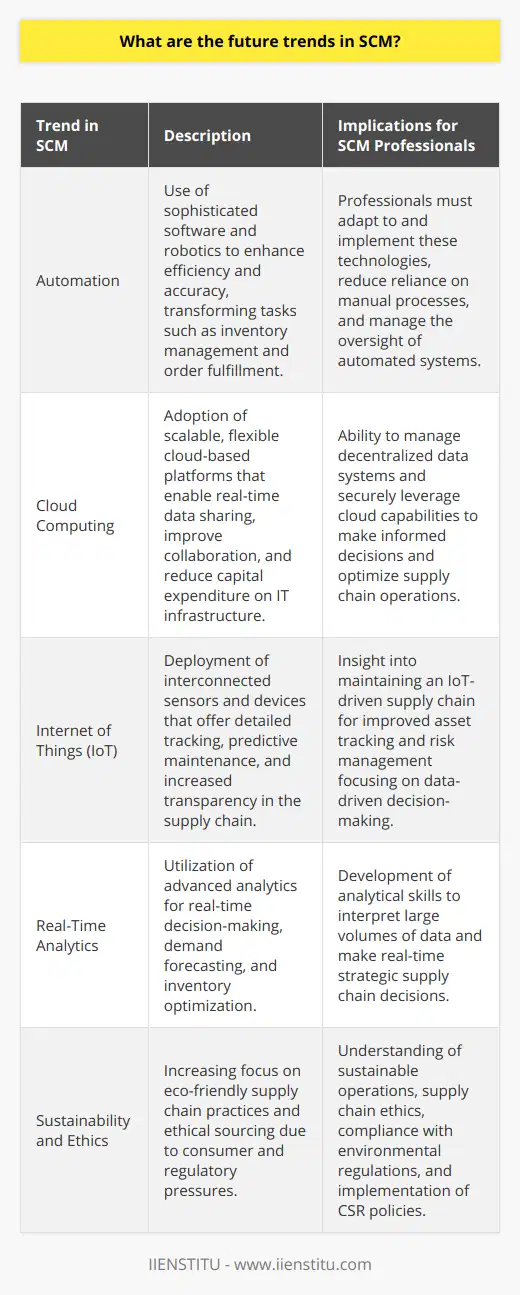
What is supply chain management in simple words?
Understanding Supply Chain Management
In essence, supply chain management (SCM) is the coordination and oversight of various interconnected activities that transform raw materials into final products. It comprises both organizational and operational aspects to execute smooth, efficient, and cost-effective movement of goods and services throughout different stages.
Key Components of SCM
**Procurement:** This stage deals with sourcing and acquiring raw materials from suppliers, including selecting vendors, negotiating terms and pricing, and managing contracts.
**Production:** Here, the focus is on transforming raw materials into finished products through manufacturing processes like assembly, quality control, and packaging.
**Inventory Control:** Proper management of inventory levels, storage, and order fulfillment ensures that products are available when customers need them, reducing stockouts and waste.
**Logistics:** This component oversees the transportation and movement of goods, from the supplier to the manufacturer and onward to the retailer or end customer.
**Information Management:** Effective SCM relies on accurate, up-to-date information about demand, production schedules, inventory levels, and transportation logistics. This data enables companies to make informed decisions and optimize their supply chain strategies.
Significance of SCM in Business
Effective supply chain management plays a pivotal role in business success as it influences factors such as cost reduction, customer satisfaction, and responding to market fluctuations. By streamlining processes, efficient supply chains reduce the time, effort, and resources required to produce and deliver products, ultimately driving down costs. Moreover, a well-managed supply chain can enhance customer satisfaction by ensuring timely and accurate deliveries.
Modern SCM Challenges and Solutions
In today's globalized economy, companies face unprecedented challenges in managing their supply chains. Supply chain disruptions due to extreme weather, geopolitical events, or transportation issues can devastate a company's ability to deliver products to customers in a timely manner. To mitigate such risks, organizations are increasingly leveraging technology like data analytics, artificial intelligence, and the internet of things to enhance visibility, predictability, and adaptability in their supply chain management efforts.
In conclusion, supply chain management is the strategic coordination of various functions and activities involved in the production and delivery of goods and services, from the acquisition of raw materials to the delivery of finished products to customers. By efficiently managing these processes, businesses can reduce costs, improve customer satisfaction, and remain competitive in today's global marketplace.
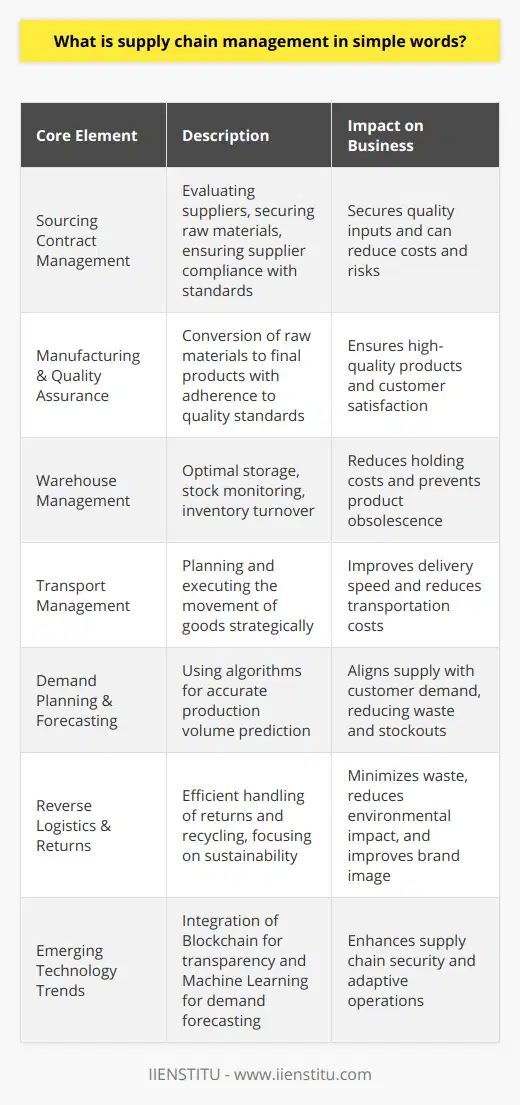
What does a supply chain management do?
Supply Chain Management Functions
Supply chain management (SCM) encompasses the coordination and collaboration of various organizations involved in creating, producing, and distributing products. It is essential in modern economies as it contributes to operational efficiency, customer satisfaction, and a firm's overall competitiveness.
Planning and Forecasting
An essential function of SCM is planning and forecasting. It involves determining the necessary resources and strategies to meet consumer demand, while also aligning these plans with the organization's strategic goals. Accurate forecasting helps to minimize waste, reduce costs, and optimize the use of resources.
Sourcing and Procurement
Another critical aspect of SCM is sourcing and procurement, or identifying and purchasing necessary goods and services from suppliers. This includes finding suppliers, negotiating contracts, and ensuring that these organizations can fulfill their commitments in terms of quality, quantity, and cost.
Manufacturing and Production
The manufacturing and production function of SCM involves transforming raw materials into finished products. This includes overseeing the entire production process, such as designing efficient production techniques, monitoring quality control, and ensuring timely delivery of finished goods.
Transportation and Logistics
Transportation and logistics are critical components of SCM. They entail the movement of raw materials, semi-finished goods, and final products between different locations within the supply chain. Efficient transportation and logistics systems ensure timely deliveries, cost savings, and improved customer satisfaction.
Inventory Management
SCM also involves inventory management, which includes tracking and controlling the storage of raw materials, work-in-process inventory, and finished goods. Efficient inventory management practices help to minimize costs associated with carrying large stocks while ensuring the right products are available when needed.
Coordination and Collaboration
Lastly, an effective SCM system promotes coordination and collaboration among various stakeholders, such as suppliers, manufacturers, distributors, and retailers. This collaboration ensures that all parties have access to vital information and contribute to the overall efficiency and success of the supply chain.
In conclusion, supply chain management is a critical aspect of modern business operations. It encompasses various functions, including planning, sourcing, manufacturing, transportation, and inventory management. Through effective coordination and collaboration among stakeholders, SCM contributes to cost savings, operational efficiency, and enhanced customer satisfaction.
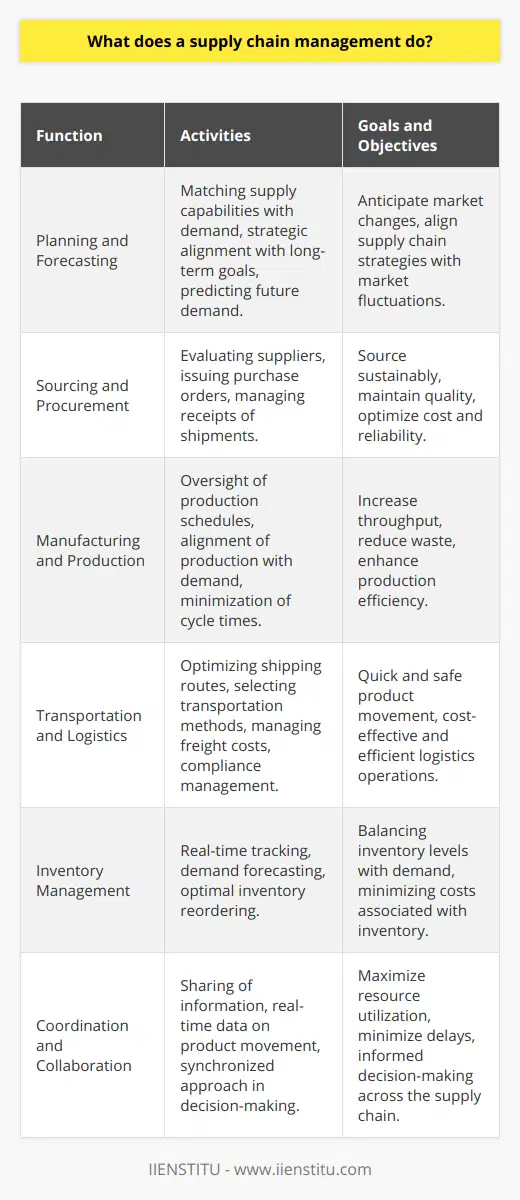
What are the 5 basic steps of supply chain management?
Understanding the 5 Basic Steps of Supply Chain Management
The first step: Planning and Strategy
Supply chain management begins with thorough planning and the development of a comprehensive strategy. Organizations need to identify their objectives and establish the methodology for achieving suitable goals.
The second step: Sourcing and Procurement
Once the strategy is in place, businesses need to source their required products and services, and analyze potential suppliers. This includes negotiating contracts while considering cost, quality, and distribution capabilities to make informed decisions.
The third step: Production and Manufacturing
The production stage of supply chain management focuses on the creation of goods and services. This step involves organizing resources, including equipment, labor, and raw materials, in order to streamline manufacturing processes and deliver quality products efficiently.
The fourth step: Storage and Inventory Management
As products are manufactured, it is important to properly store and track them, ensuring accurate inventory management. Adequate storage facilities and efficient processes are vital for minimizing stockouts, overstocking, and general inventory costs.
The fifth step: Transportation and Distribution
The final step of the supply chain management involves delivering the finished products to customers or retailers through various transportation modes. Organizations must optimize their distribution networks and choose appropriate transportation methods both to increase cost-effectiveness, and to provide the best possible customer service.
In conclusion, the basic steps of supply chain management are planning and strategy development, sourcing and procurement, production and manufacturing, storage and inventory management, and transportation and distribution. By effectively implementing these steps, organizations can help ensure efficient and cost-effective operations while maintaining customer satisfaction.
